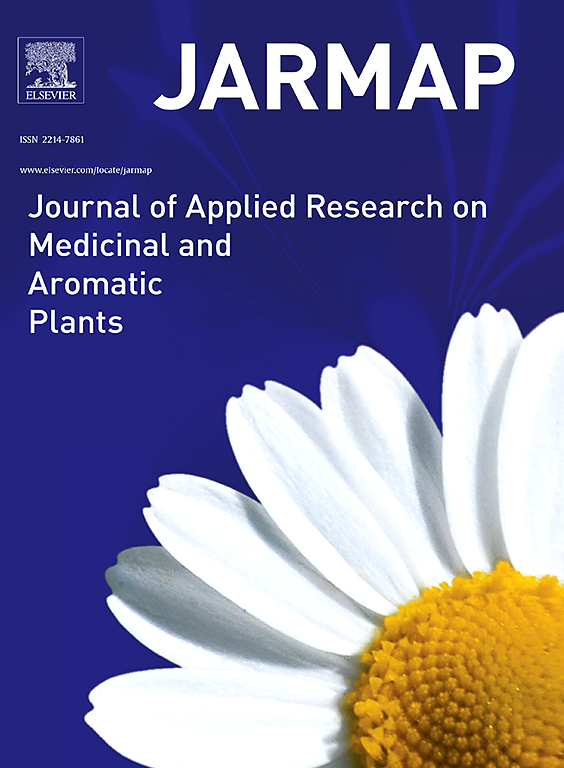埋藏的奶蓟草(Silybum marianum (L.) Gaertn.
IF 3.6
2区 农林科学
Q1 PLANT SCIENCES
Journal of Applied Research on Medicinal and Aromatic Plants
Pub Date : 2024-09-26
DOI:10.1016/j.jarmap.2024.100581
引用次数: 0
摘要
奶蓟草(Silybum marianum (L.) Gaertn.)是一种药用/油料作物,成熟时会结出休眠种子。种子在收获前会释放到土壤种子库中,因此会造成农业生态系统中的杂草控制问题。迄今为止,有关奶蓟草种子在土壤种子库中休眠状态的动态变化、存活率和持久性的信息还很缺乏。因此,本研究调查了原地(在实验室干燥)和原地(埋在土壤中)储存条件对休眠打破和发芽的影响。在 5 至 35 ° C 的恒温条件下,对新鲜收获的种子(FH)进行了发芽率测试,测试条件包括光照/黑暗和黑暗条件下添加或不添加 GA3。此外,还于2019年6月在田间以5、10和20厘米的深度掩埋了FH种子,并在掩埋2-12个月后挖出种子,评估其发芽情况。在任何试验条件下,FH 种子都不萌发,但 GA3 和干藏后熟提高了萌发率,表明种子具有非深度生理休眠(PD)。随着干藏后熟期的增加,种子萌发的最高温度(30 °C)没有变化,但萌发的最低温度下降到 5 °C,即种子表现出 2 型非深度生理休眠。增加种子埋藏深度可延长完全解除休眠所需的原地后熟期。此外,种子在土壤中的持久性也受埋藏深度的影响。埋藏在 5 厘米处的种子具有短暂的种子库,而埋藏在 10 厘米和 20 厘米处的种子则具有持久的种子库。本文章由计算机程序翻译,如有差异,请以英文原文为准。
Dormancy-break and germination of buried milk thistle (Silybum marianum (L.) Gaertn.) seeds
Milk thistle (Silybum marianum (L.) Gaertn.) is a medicinal/oil crop plant that produces dormant seeds at maturity. Seeds are released before harvest into the soil seed bank and hence can cause weed control problems in agricultural ecosystems. So far, information on dynamic changes of dormancy state, viability and persistence of milk thistle seeds in the soil seed bank is lacking. Accordingly, in this study the effects of ex-situ (dry in laboratory) and in-situ (buried in soil) storage conditions on dormancy-break and germination were investigated. Freshly harvested (FH) seeds were tested for germination at constant temperature ranging from 5 to 35 °C under both light/dark and dark conditions with or without GA3. Also, FH seeds were buried in June 2019 at depths of 5, 10, and 20 cm in a field and exhumed after 2–12 months of burial and assessed for germination. FH seeds did not germinate at any test conditions, but GA3 and after-ripening in dry storage increased germination, indicating that seeds have non-deep physiological dormancy (PD). With increased dry after-ripening, the ceiling temperature for germination (30 °C) did not change but the base temperature for germination decreased to 5 °C, i.e, seeds exhibited type 2 non-deep PD. Increased seed burial depth increased the length of the in situ after ripening period necessary for complete dormancy alleviation. Furthermore, persistence of seeds in the soil was affected by burial depth. Seeds buried at 5 cm had a transient seed bank and those at 10 and 20 cm a persistent seed bank.
求助全文
通过发布文献求助,成功后即可免费获取论文全文。
去求助
来源期刊

Journal of Applied Research on Medicinal and Aromatic Plants
Pharmacology, Toxicology and Pharmaceutics-Drug Discovery
CiteScore
6.40
自引率
7.70%
发文量
80
审稿时长
41 days
期刊介绍:
JARMAP is a peer reviewed and multidisciplinary communication platform, covering all aspects of the raw material supply chain of medicinal and aromatic plants. JARMAP aims to improve production of tailor made commodities by addressing the various requirements of manufacturers of herbal medicines, herbal teas, seasoning herbs, food and feed supplements and cosmetics. JARMAP covers research on genetic resources, breeding, wild-collection, domestication, propagation, cultivation, phytopathology and plant protection, mechanization, conservation, processing, quality assurance, analytics and economics. JARMAP publishes reviews, original research articles and short communications related to research.
 求助内容:
求助内容: 应助结果提醒方式:
应助结果提醒方式:


